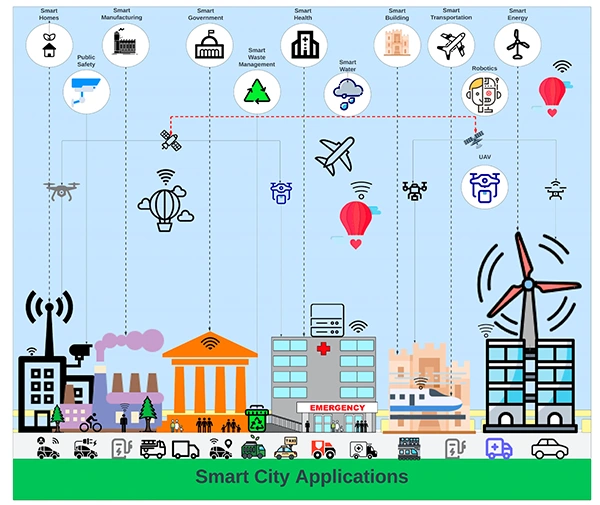Top Features of IOT Satellite Technology
The combination of satellite technology with the Internet of Things (IoT) is changing the scene of data management and connection in many sectors. Especially in rural and underprivileged locations, IoT satellite technology expands the reach of conventional networks by offering consistent and continuous connections.
With the tech becoming more sophisticated and advanced, the Internet of Things is gaining momentum. According to Statista, “The number of Internet of Things (IoT) devices worldwide is forecast to almost double from 15.9 billion in 2023 to more than 32.1 billion IoT devices in 2030”. Hence, here we investigate the main characteristics of IoT satellite technology that enable it to be a transforming agent in contemporary networking.
Global Reach
Global coverage of IoT technology is among its most significant characteristics. Satellite networks can reach even the most far-off and inaccessible regions, unlike terrestrial networks, which are often constrained by geography and infrastructure restrictions. From rural farms to vast seas and the Rocky Mountains, this coverage guarantees devices can remain connected wherever on Earth.
Farmers in far-off locations may utilize sensors to monitor soil conditions and crop health, therefore obtaining real-time data to best guide their agricultural operations.
Ships and offshore platforms might remain linked for navigation, weather updates, and emergency communications.
Low Latency Interaction
Thanks in great part to developments in satellite technology—especially the Low Earth Orbit (LEO) satellite deployment—communication latency has dropped to a noticeable extent. Faster data transfer and reduced latency are made possible by LEO’s closer orbit to the Earth than with conventional geostationary orbiters.
Real-time operation of autonomous cars depends on low-latency communication, therefore, guaranteeing their ability to respond fast to changing surroundings.
Highly Scalable

IoT networks can serve a lot of devices without any performance loss. Accommodating the increasing number of these devices installed in different fields depends on this scalability. Not only in an individual’s life, but IoT plays a major role at a macro level too.
For instance, managing enormous numbers of sensors and equipment for traffic control, trash management, and energy distribution helps define smart cities. Monitoring and managing vast networks of machinery and equipment in manufacturing and energy industries is part of industrial IoT.
Improved Safety
Strong security elements including encryption and safe data transfer techniques come from satellite communication. Particularly in military uses and necessary infrastructure, this improved security is very needed for safeguarding sensitive data sent by IoT devices.
Data security from systems of water supplies, electricity grids, and other vital services. They are guaranteeing safe communication for surveillance and military activities. In a common world scenario for civic people, various motion-detecting cameras, sensors, etc., are all examples of the Internet of Things.
Affordable Implementation
Technological developments and more competition among these service providers have drastically cut the cost of establishing and maintaining satellite networks. The technology economy enables a wider spectrum of businesses and makes its use feasible.
Small and Medium-sized Enterprises (SMEs) can use the connection for the same purposes free from excessive expenses. Setting up temporary communication networks rapidly and reasonably in disaster-torn communities.
Compatibility With Current Internet of Things Systems
IoT technology might easily interact with current terrestrial IoT systems to produce hybrid systems. All of this is possible by using ground-based communication capabilities as well as satellite ones. This integration generally improves network performance and resilience.
Along with that, integrating remote patient monitoring technologies with central databases can help to manage holistically in healthcare. Since the inception of this article, it is pretty clear that almost every industry or sector has benefitted from the IoT.
Real-Time Analytics for Data
Real-time data collecting and analytics are made possible by IoT satellite networks. These networks are responsible for providing useful insights that could guide operational effectiveness and decision-making. Diving deeper, and analyzing data as it is produced, lets one react quickly to new problems and possibilities. Constant observation of air and water quality helps to identify and quickly solve pollution causes.
Pollution measurement can be one of the best use cases for the Internet of Things. With its modern tech, IoT can also be tested or examined if it can provide the right insights into real-time data or not.
Conclusion
One of the revolutionary developments extending the scope and capabilities of conventional IoT networks is IoT satellite technology. For a variety of uses, its features—global coverage, dependable connection, low latency, scalability, better security, cost-effectiveness, seamless integration, and real-time data analytics—make it an indispensable tool.
As this technology develops, its effects on sectors ranging from transportation to agriculture, and healthcare to environmental monitoring will only become more noticeable, inspiring creativity and raising general efficiency as well.
This article covered all these necessary details regarding the subject and how it is creating a change in society. Share this article with friends and peers to spread the word.
Also Read: Why Every Investor Should Have a Demat Account
